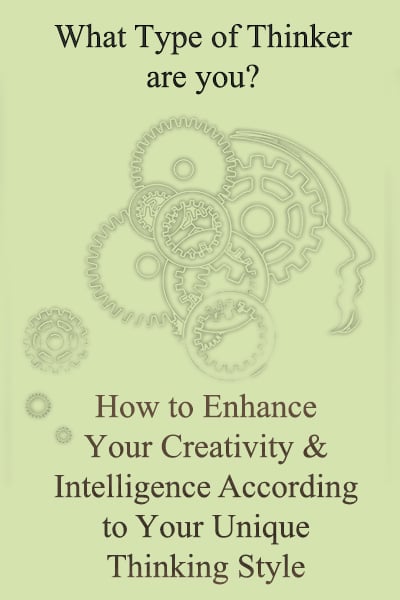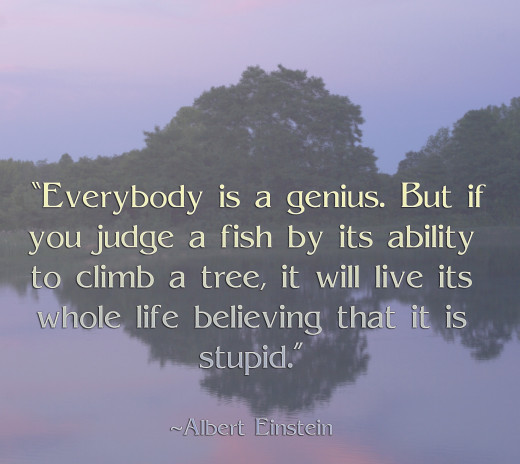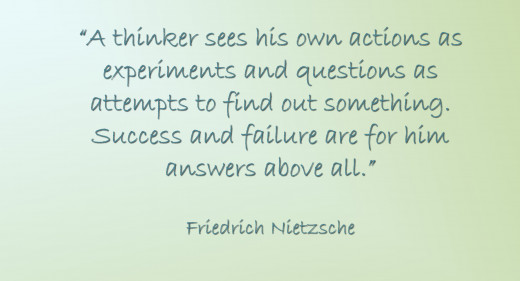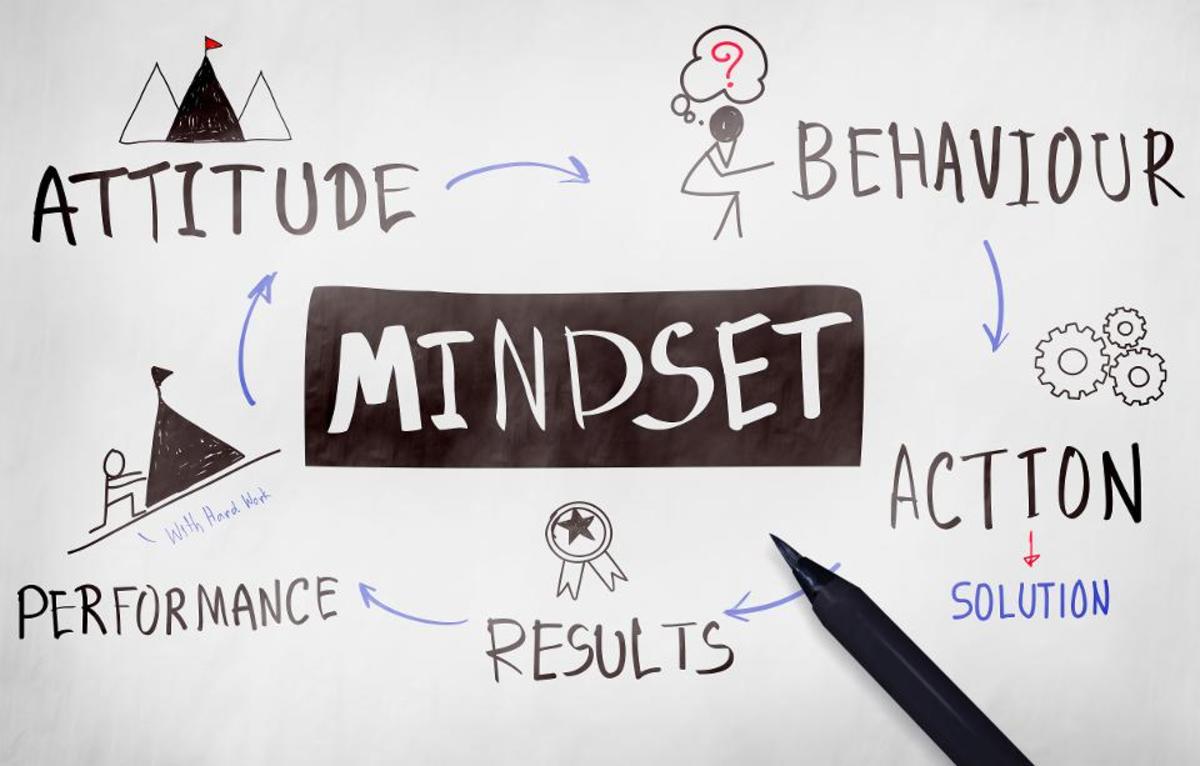How to Improve Your Creativity and Intelligence

Every human brain is nearly identical, but we all think differently. Many are not acutely aware of thought patterns or how they affect our perceptions of the world and how we learn about that world.
Understanding how and why you think the way you do can help you enhance your intelligence and creativity. You can teach yourself how to learn in new ways and find the most effective learning techniques for you.
Have you ever become frustrated while taking a class or reading an instruction manual? Our schools tend to focus on a set style of teaching and as a result, many children and adults alike struggle to learn and reach their fullest potential.
Do you know what kind of thinker you are?
Personal Assessment
First, answer the following questions. There are no right or wrong answers so be honest in your assessment.
- When contemplating a problem at work, do you look for solutions among a set number of already established facts or protocols? Or, do you feel anxious accepting the given answers and need to consider even more possibilities before you can make a choice because something might be missing?
- Do you feel the need to solve a problem immediately and move on, so you tackle it right away? Or do you like to take some time to ponder the situation, carefully considering and exploring multiple angles, possibilities and approaches?
- Does the idea of solving a problem with no clear directions make you anxious or does it excite you?

Convergent vs Divergent Thought Patterns
If you are the person who feels wary about not having clear directions to solve a problem and you tend to look for already established protocols and facts, you display convergent thinking. Convergent thinkers see things in life as having a limited, set number of options. They are more comfortable choosing from these predetermined ideas.
Divergent thinkers are the opposite. They become anxious with only a limited amount of choices or options. They want to find and explore more choices. Having more options allows them to feel freer and not as confined. They find too much structure to be stifling and may second guess themselves more often than Convergent thinkers. “But what if I had done this instead?” etc.
Neither type is “right” or “wrong”. There is a time and place for both. A surgeon, for example, should be focused on a set technique and confident in his ability to choose the correct procedure and perform it effectively and efficiently. You don't want a surgeon who dawdles or second guesses themselves while giving you open-heart surgery.
On the other hand, those who are artistic and creative will feel very stifled if they only have limited choices for personal expression. Ideally, you want to have a mind that is open and comfortable with both types of thinking.
You don't want to be wholly analytical at all times with no flexibility, but you don't want to be a flighty space cadet when it's time to pay the bills and manage your money either. Life requires both types of thinking! Most of us will favor one over the other, the key is in developing a balance.
Here's another way to look at it. Critical, convergent thinking is used by teachers to develop a common understanding. It is the process of processing information around a central point, to bring all thoughts from different directions back to the center or core conclusion.
Divergent thinking starts with a central theme or idea, then branches out. If you have ever done an outline or mind map, that is a perfect example of divergent thinking. One thought or idea, coming from another, and another from that one etc. This is a process that moves outward from the center and points to a variety of perspectives. It is the best form of thinking for complex problems.

How Thoughts and Feelings Intertwine
Divergent and convergent are the two most basic types of thought. The human mind is quite incredible and complex in how it learns and processes information.
What's even more incredible is that we can undo things we have learned and reprogram our brains, much like a computer. When you can step outside of your mind a bit and observe it; you'll be quite surprised where your mind wanders.
Our thoughts, feelings and preconceived ideas are always working in tandem, influencing one another. Those who claim their emotions never get in the way of their judgment are mistaken. To some degree, our feelings do in fact shape and influence our judgment, whether we accept that or not.
That's not to say that there are not people highly skilled in recognizing how their emotions are shaping their thoughts. This allows them to set aside (but not remove) emotions from their critical thinking skills. Objective thought is not the removal of emotion, but working around it.
Think of a time when you changed your mind about something you thought to be true for a long time. What caused you to change your mind? Did you learn through having a new experience that changed your perspective? Did you intuitively sense that what you thought you knew wasn't working anymore? Thoughts and feelings converged together to help you come to a new understanding.
When feelings are out of control or left unchecked it can lead to disordered thinking, called “pathological thought” This is the place where emotions are too out of control, distorting the way the person perceives reality.
Have you ever known someone you swore had “no sense of reality” or totally misunderstood or misinterpreted something you said or did? Chances are they were engaged in a bit of “pathological thought”. Unchecked, these types of thought processes can be behind many mental and emotional disorders.
One of the greatest thought processes involves ideal balance. Psychological thought involves knowing and understanding how your thoughts and emotions are affecting your perception of a situation.
An example might be working on a project with a difficult co-worker. Instead of just feeling upset at the person and reacting to those emotions, a psychological thinker is going to look deeper into the situation. She might ask herself, how does this person's behavior affect me and why? What makes them behave this way? What can I do to better understand or connect with this person? How can I manage this, so that the project can still be completed?
This shows someone who is proactive, who is aware of her emotions and using them to establish empathy for the other person, while also coming up with a logical plan of action to deal with a problem. This “whole brain” type of thinking is preferable for problem-solving in life and in the workplace.
Enhancing Your Thought Processes
The first key is understanding how you think. We already established previously convergent vs divergent. Next, it's time to gain more understanding of how your mind/emotions are working together, or against each other.
Ask yourself the following questions and answer honestly. It can highlight your strengths and help you pinpoint other areas to work on.
When you are upset, do you become forgetful or struggle to focus?
If you struggle to think clearly when you are upset, it can indicate an imbalance present with mind/emotions. Do you tend to think things through? Or do your emotions tend to determine your course? If you find you are led too much by your emotions, it may be time to engage in activities that help you balance mind/emotion more.
Do you tend to avoid emotions by becoming engrossed in other activities? (games, tv, etc.)
A need to escape one's emotions through distraction can indicate that you may not be approaching problems in life from a well-rounded perspective. If you are avoiding emotions because they make you uncomfortable and rely solely on analytical skills to “fix” problems, chances are you would benefit from finding more balance. Empathy and being able to understand and experience the feelings of others can improve your communications and problem-solving skills.
Can you sit in silence and be comfortable? Or does it make you very anxious and you seek a distraction immediately?
Those who feel anxiety around being in silence often struggle with their thoughts/emotions. Anxiety and avoidance may be a couple of issues you should learn to tackle in new ways. Meditation is a form of mindfulness where you learn to quiet the mind and pay attention to your thoughts. This silence gives great insight into where your mind wanders so that you can better control it, rather than allowing it to control you without filters.
Do you regularly exercise your brain by doing puzzles, reading complex material or solving problems until your brain hurts?
This is an excellent way to keep the analytical, problem-solving part of the mind sharp. Those who work out their brains regularly, in combination with other healthy lifestyle choices, are far less likely to suffer from cognitive decline as they age. It's never too late to exercise the mind – and it should be done regularly.
Do you regularly engage in creative activities and personal expression through art, writing, music etc.?
Using your creativity helps expand your awareness and develops the deeper levels of psychological thought that allow you to properly balance your mental processes and emotions. Every person should engage in both analytical problem-solving activities and personal expression activities (paint, draw, write in a journal). Balancing both promotes whole brain thinking.
Know and Understand Your Learning Style
One of the most important things to consider is appealing directly to your learning style. One of the reasons so many kids dislike school is that the curriculum being taught is the same for everyone. It can be difficult to teach a room full of 30 students in a way that appeals to the learning style of each one.
It's important to know your preferred learning style so that you can adapt and learn things in new ways. For example, some teachers are able to make math less scary, by teaching it from a more creative perspective and attaching those concepts to activities like art.
When someone is teaching you something completely new, do you prefer listening to examples, seeing the problem demonstrated, or do you want to experience the problem in a more hands-on manner?
Auditory, visual and kinesthetic learning are all integral to the ability to learn and assimilate knowledge, however, most individuals will tend to favor one over the others. It is very rare to be naturally balanced in all three and that's fine.You can develop skills that help you enhance all three learning styles, but to make the process more enjoyable, try to focus on your natural strengths.
Knowing what you prefer can make life and learning much easier, especially for children. If you spend your whole time in a class being “talked at” by a teacher, when you are a more visual learner, you will grow frustrated with the process. Boredom and frustration can kill curiosity and a love of learning and that is tragic.
On the other hand, if you are someone who does better “hands on” you may need to enhance a classroom experience with real-world experiences that allow you to physically manipulate objects. Go home and test out that new theory or idea.
Have you ever read an instruction manual and wanted to pull your hair out, so you just dug in and put the widget together yourself? Chances are you are a kinesthetic learner who thrives with hands-on experience, something tragically lacking in many schools.
Find ways to enhance knowledge and stretch your mind in new directions. Do what you can to make learning a life-long pursuit. The love of learning pushes us to use our minds in new ways, and understanding our minds and how they work, can instill a renewed love of learning!
How Well Do You Know Your Mind?
© 2014 Christin Sander








